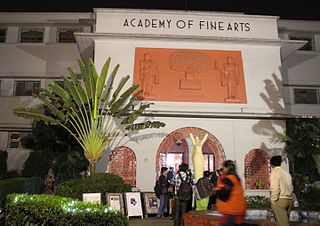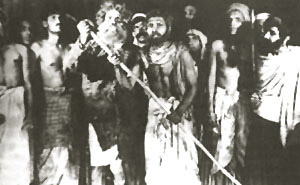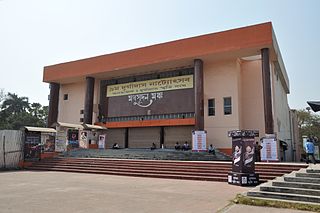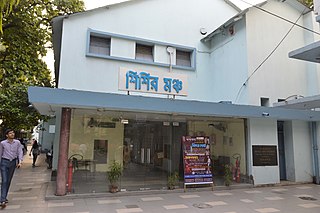
West Bengal is a state in the eastern portion of India. It is situated along the Bay of Bengal, along with a population of over 91 million inhabitants within an area of 88,752 km2 (34,267 sq mi). West Bengal is the fourth-most populous and thirteenth-largest state by area in India, as well as the eighth-most populous country subdivision of the world. As a part of the Bengal region of the Indian subcontinent, it borders Bangladesh in the east, and Nepal and Bhutan in the north. It also borders the Indian states of Jharkhand, Odisha, Bihar, Sikkim and Assam. The state capital is Kolkata, the third-largest metropolis, and seventh largest city by population in India. West Bengal includes the Darjeeling Himalayan hill region, the Ganges delta, the Rarh region, the coastal Sundarbans and the Bay of Bengal. The state's main ethnic group are the Bengalis, with the Bengali Hindus forming the demographic majority.

Kolkata is the capital of the Indian state of West Bengal. It is on the eastern bank of the Hooghly River 80 km (50 mi) west of the border with Bangladesh. It is the primary business, commercial, and financial hub of Eastern India and the main port of communication for North-East India. According to the 2011 Indian census, Kolkata is the seventh-most populous city in India, with a population of 45 lakh (4.5 million) residents within the city. It is a part of Kolkata Metropolitan Area which has a population of over 1.41 crore (14.1 million) residents making it the third-most populous metropolitan area in India. In 2021, the Kolkata metropolitan area crossed 1.5 crore (15 million) registered voters. The Port of Kolkata is India's oldest operating port and its sole major riverine port. Kolkata is regarded as the cultural capital of India. Kolkata is the second largest Bengali-speaking city after Dhaka. It has the highest number of nobel laureates among all cities in India.

Rabindra Sarobar is an artificial lake, garden and park in South Kolkata in the Indian state of West Bengal. The name also refers to the area surrounding the lake. It is flanked by Southern Avenue to the North, Shyamaprasad Mukherjee Road to the West, Dhakuria to the East and the Kolkata Suburban Railway tracks to the south.

The Academy of Fine Arts, in Kolkata is one of the oldest fine arts societies in India.

The culture of West Bengal is an Indian culture which has its roots in Bengali literature, music, fine arts, drama and cinema. Different geographic regions of West Bengal have subtle as well as more pronounced variations between each other, with Darjeeling Himalayan hill region and Duars showing particularly different socio-cultural aspects.

Bengali theatre primarily refers to theatre performed in the Bengali language. Bengali theatre is produced mainly in West Bengal, and in Bangladesh. The term may also refer to some Hindi theatres which are accepted by the Bengali people.

Sudhindra Sircar, also known as Badal Sarkar, was an influential Indian dramatist and theatre director, most known for his anti-establishment plays during the Naxalite movement in the 1970s and taking theatre out of the proscenium and into public arena, when he transformed his own theatre company, Shatabdi as a third theatre group. He wrote more than fifty plays of which Ebong Indrajit, Basi Khabar, and Saari Raat are well known literary pieces. A pioneering figure in street theatre as well as in experimental and contemporary Bengali theatre with his egalitarian "Third Theatre", he prolifically wrote scripts for his Aanganmanch performances, and remains one of the most translated Indian playwrights. Though his early comedies were popular, it was his angst-ridden Evam Indrajit that became a landmark play in Indian theatre. Today, his rise as a prominent playwright in 1960s is seen as the coming of age of Modern Indian playwriting in Bengali, just as Vijay Tendulkar did it in Marathi, Mohan Rakesh in Hindi, and Girish Karnad in Kannada.

Bagbazar is a neighbourhood of North Kolkata, in Kolkata district in the Indian state of West Bengal. The area, under Shyampukur police station of Kolkata Police, has been, along with neighbouring Shyambazar, the citadel of the Bengali aristocracy. Bagbazar has played an active role in growth and development of Kolkata.

Nandan is a government-sponsored film and cultural centre in Kolkata, India. The primary aim of the cultural hub is to encourage and facilitate cinematic awareness in society. It includes a few comparatively large screens housed in an impressively architectured building. The complex, besides being a modern cinema and cultural complex, is a popular destination for the young and the aged alike.
Paschim Banga Natya Akademi is a learned society for drama and theatre in West Bengal, India. Established on 26 September 1987, it is a wing of the Department of Information and Cultural Affairs, Government of West Bengal. The aim of this society is to develop skill and expertise, to document and archive the history of theater of Bengal, to disseminate information, to understand theories, to promote and project significant creativity in the field.
Sujata Sadan is a theatre auditorium in Kolkata, West Bengal. The theatre auditorium is located at 107 Harish Mukherjee Road, Kolkata 700026. Bengali theatre group like Swapnasandhani regularly perform in this auditorium.

Madhusudan Mancha is an auditorium in Dhakuria, Kolkata, West Bengal, India. It is named after Bengali poet Michael Madhusudan Dutt. This is controlled and managed by the Information and Cultural Affairs Department, Government of West Bengal. This auditorium is regularly used for theatres. This auditorium is inaugurated on 12 October 1995 by Jyoti Basu, Chief Minister of West Bengal at that time.

Mahajati Sadan is an auditorium located on Chittaranjan Avenue in Kolkata, West Bengal, India. This auditorium is regularly used for Bengali theatres. Seminars are also organized in the seminal hall of Mahajati Sadan. This auditorium was an important part of India's freedom movement. Rabindranath Tagore called this auditorium "House of the Nation".

Sisir Mancha is an auditorium located on Acharya Jagadish Chandra Bose Road in Kolkata, West Bengal, India. This auditorium is regularly used for Bengali theatres. The auditorium is adjacent to Rabindra Sadan-Nandan Complex. The theatre auditorium is named after Bengali dramatist Sisir Kumar Bhaduri and it was established in 1978.

Sealdah is a neighbourhood of Central Kolkata in Kolkata district in the Indian state of West Bengal.
Tapas Sen was a noted Indian stage lighting designer, who was an important figure in 20th-century Indian theatre. He started working with Bengali theatre movement in Kolkata in the late 1940s, along with noted directors, Utpal Dutt and Shambhu Mitra. Later he became a founding member of the Indian People's Theatre Association's (IPTA), Delhi chapter, and worked closely with Hindi theatre. Through his career stretching five decades he worked theatre directors, Ebrahim Alkazi, Vijay Tendulkar, and also dancers Sadhana Bose, Chandralekha, Birju Maharaj and Kelucharan Mahapatra. He was known not only for his creative stage lighting, but also had a significant impact on the work of leading theatre director of the time.
Ward No. 25, Kolkata Municipal Corporation is an administrative division of Kolkata Municipal Corporation in Borough No. 4, covering parts of Rambagan, Girish Park, Jorasanko and Simla neighbourhoods in North Kolkata, in the Indian state of West Bengal.
Ward No. 26, Kolkata Municipal Corporation is an administrative division of Kolkata Municipal Corporation in Borough No. 4, covering parts of Ramdulal Sarkar Street and Hedua Park neighbourhoods in North Kolkata, in the Indian state of West Bengal.
Ward No. 39, Kolkata Municipal Corporation is an administrative division of Kolkata Municipal Corporation in Borough No. 5, covering parts of Marcus Square, College Street and Simla neighbourhoods in North Kolkata, in the Indian state of West Bengal.














